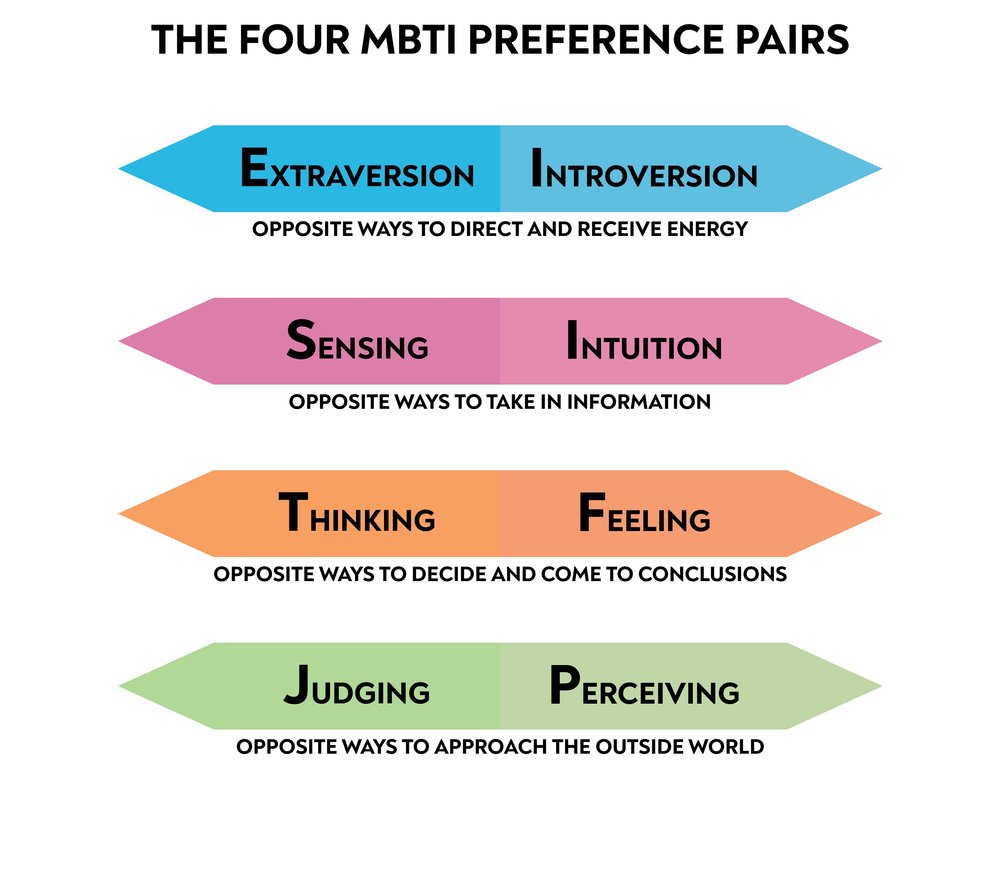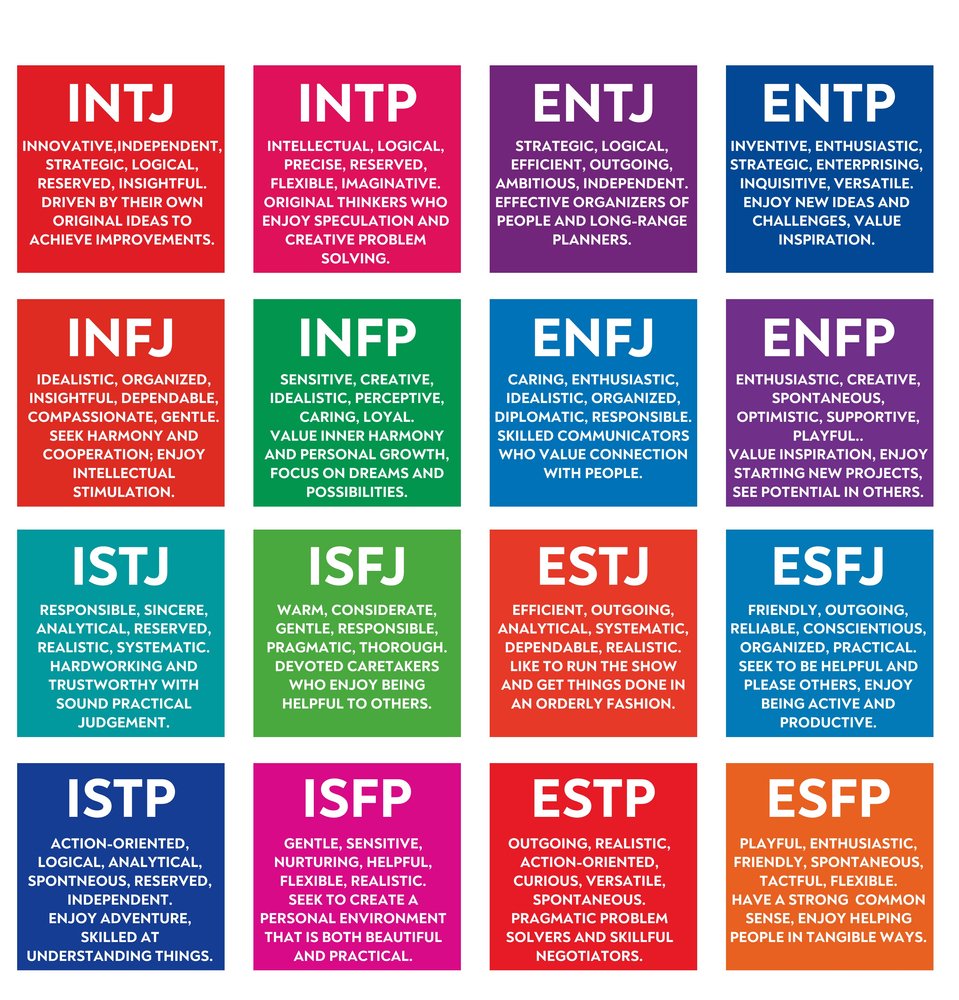Know Your Client: Using the Myers-Briggs Indicator to Enhance Personal Training
Using the Myers-Briggs Type Indicator (MBTI) can challenge the assumption that one-size-fits-all training approaches are effective. By tailoring their coaching style and communication to match the individual needs of each client's personality type, personal trainers can create a more personalized and effective training experience.
The MBTI is a personality assessment tool that identifies an individual's preferences in how they perceive and make decisions. It is based on the theory of psychological types developed by Carl Jung and was created by Isabel Briggs Myers and Katherine Briggs. The assessment consists of 16 different personality types, which are represented by a combination of four dichotomies:
Extraversion vs. Introversion (E or I) - This dichotomy refers to where individuals focus their attention and get their energy. Extraverts focus on the outer world of people and things, while introverts focus on their inner world of thoughts and ideas.
Sensing vs. Intuition (S or N) - This dichotomy refers to how individuals take in and process information. Sensors rely on their five senses to gather information, while intuitives rely on patterns and possibilities to make sense of the world.
Thinking vs. Feeling (T or F) - This dichotomy refers to how individuals make decisions. Thinkers rely on logical analysis and objective criteria, while feelers rely on personal values and subjective considerations.
Judging vs. Perceiving (J or P) - This dichotomy refers to how individuals approach the outer world. Judgers prefer a planned and organized approach, while perceivers prefer a spontaneous and adaptable approach.
The 16 personality types are:
ISTJ - Introverted, Sensing, Thinking, Judging: These individuals are dependable, practical and responsible. They are systematic and orderly in their approach to problem solving and decision making.
ISFJ - Introverted, Sensing, Feeling, Judging: These individuals are loyal, supportive and dependable. They are sensitive to the needs of others and are motivated to help and serve.
INFJ - Introverted, Intuitive, Feeling, Judging: These individuals are compassionate, idealistic and empathetic. They have strong insight into people and situations and are motivated to help others.
INTJ - Introverted, Intuitive, Thinking, Judging: These individuals are analytical, strategic and independent. They have a clear vision of their goals and work towards them efficiently.
ISTP - Introverted, Sensing, Thinking, Perceiving: These individuals are independent, logical and adaptable. They are curious and hands-on learners and are drawn to understanding how things work.
ISFP - Introverted, Sensing, Feeling, Perceiving: These individuals are sensitive, compassionate and artistic. They are in touch with their emotions and appreciate beauty and harmony in the world.
INFP - Introverted, Intuitive, Feeling, Perceiving: These individuals are idealistic, empathetic and curious. They have strong values and are driven to help others and make the world a better place.
INTP - Introverted, Intuitive, Thinking, Perceiving: These individuals are logical, analytical and independent. They are curious and enjoy exploring new ideas and concepts.
ESTJ - Extraverted, Sensing, Thinking, Judging: These individuals are logical, practical and efficient. They are decisive and enjoy taking charge and organizing others.
ESFJ - Extraverted, Sensing, Feeling, Judging: These individuals are outgoing, supportive and dependable. They are sensitive to the needs of others and are motivated to help and serve.
ENFJ - Extraverted, Intuitive, Feeling, Judging: These individuals are outgoing, compassionate and empathetic. They have strong insight into people and situations and are motivated to help others.
ENTJ - Extraverted, Intuitive, Thinking, Judging: These individuals are confident, strategic and assertive. They have a clear vision of their goals and work towards them efficiently, often taking charge and leading others.
ESTP - Extraverted, Sensing, Thinking, Perceiving: These individuals are outgoing, practical and adaptable. They enjoy taking risks and are drawn to understanding how things work.
ESFP - Extraverted, Sensing, Feeling, Perceiving: These individuals are outgoing, spontaneous and artistic. They are in touch with their emotions and appreciate beauty and harmony in the world.
ENFP - Extraverted, Intuitive, Feeling, Perceiving: These individuals are outgoing, curious and idealistic. They have strong values and are driven to help others and make the world a better place.
ENTP - Extraverted, Intuitive, Thinking, Perceiving: These individuals are outgoing, analytical and independent. They are curious and enjoy exploring new ideas and concepts.
It's important to note that these types are not meant to define an individual but rather to provide an understanding of their natural tendencies and preferences. It also should be acknowledged that some people may identify with more than one type, or may shift between types in different situations or stages of life.
In the context of coaching boxers, the MBTI can be a useful tool for coaches to understand the strengths and weaknesses of their athletes and tailor their training and coaching style accordingly. For example, an individual who is identified as an introvert may need more alone time to process their thoughts and emotions, while an extravert may thrive in a more social and interactive training environment.
Sensing types tend to be more practical and detail-oriented, while intuition types are more imaginative and abstract. A coach who is able to understand these differences can better support their athletes by adapting their training strategies to match their preferred learning style.
Thinking and feeling types tend to approach decision-making differently. Thinking types rely on logical analysis and impersonal criteria, while feeling types consider personal values and the impact on others. A coach who is aware of these differences can help their athletes develop more balanced decision-making skills by incorporating both approaches.
Finally, judging and perceiving types tend to have different approaches to structure and flexibility. Judging types prefer a more structured and organized approach, while perceiving types prefer a more flexible and adaptable approach. A coach who understands these differences can help their athletes develop a training schedule that works best for them and their individual needs.
The MBTI can help personal trainers take a tailored approach to each client, and challenge the assumption that one-size-fits-all training is effective. By incorporating MBTI assessments, trainers can help their clients achieve their goals with greater success and satisfaction. In the world of fitness, a little personality can go a long way.
Here are some questions based on the MBTI for personal trainers to reflect on and apply:
How can you tailor your communication style to better match the client's preferred communication style, as indicated by their MBTI type? For example, how might an introverted client prefer to receive feedback compared to an extroverted client?
How might the client's MBTI type affect their approach to fitness, and how can you design the training program to meet their unique needs and motivations? For instance, how might a client with a preference for sensing respond differently to a workout program than a client with a preference for intuition?
In what ways can you leverage the client's MBTI strengths to create a more effective and enjoyable training experience? For example, how might you use a client's preference for feeling to encourage them to stick with a program long-term?
How can you use the client's MBTI type to anticipate potential challenges or obstacles, and proactively address them in the training program? For instance, how might you adapt a workout program to better suit a client with a preference for judging who may prefer a more structured, goal-oriented approach?
What role might your own MBTI type play in your approach to training, and how can you leverage your strengths and manage your weaknesses to best serve the client? For example, how might a trainer with a preference for thinking approach a client with a preference for feeling in a way that resonates with them?
Reference
Myers, B. I., Myers, B. P. (1995) Gifts Differing: Understanding Personality Type, CPP


